U.S. consumer prices rose 0.3 percent in June, the Department of Labor said Tuesday.
Economists had forecast a 0.3 percent rise compared with the previous month. In May, the consumer price index (CPI) climbed just 0.1 percent.
Compared with a year earlier, the consumer price index rose 2.7 percent, slightly above the consensus forecast for 2.6 percent.
Core prices, which exclude volatile food and energy categories, rose 0.2 percent. Economists had forecast a rise of 0.3 percent. In May, core CPI rose 0.1 percent. Compared with a year ago, core CPI rose 2.9 percent, matching expectations.
Core goods prices rose 0.2 percent, the largest increase since a 0.2 percent rise in February. In May, core goods prices were flat. In April, core goods prices rose 0.2 percent. In March, they fell 0.1 percent. Compared with a year ago, core goods prices are up a slight 0.7 percent.
Prices of vehicles fell in June. New car and truck prices fell 0.3 percent for the second consecutive month and are up just 0.2 percent compared with a year earlier. Used car prices tumbled 0.7 percent, the fourth straight month of declines. Compared with a year ago, used car prices are up 2.8 percent.
Food prices increased 0.3 percent, with grocery prices rising 0.3 percent and dining out prices moving up 0.4 percent.
The energy index climbed 0.9 percent in June as the gasoline index increased 1.0 percent over the month.
Apparel prices increased by a sharp 0.4 percent, the first increase after months of falling prices. Compared with a year ago, however, apparel prices are down 0.5 percent. This is a category of heavily imported items and likely reflects tariff pressure. Men’s suit prices, however, fell 2.7 percent, the second straight monthly decline. Suits for women fell 0.4 percent while dress prices climbed 3.9 percent. Prices of clothes for girls and boys fell.
Footwear prices rose 0.7 percent. Men’s shoe prices shot up 2.6 percent but children’s shoe prices fell 1.7 percent. Women’s shoes rose 0.7 percent.
Prices rose significantly on household furnishings and appliances, suggesting tariffs have created positive price pressure in these categories.
The larger services side of the economy saw prices rise 0.3 percent, excluding energy-related services. Shelter prices rose 0.2 percent.
Read the full article here


